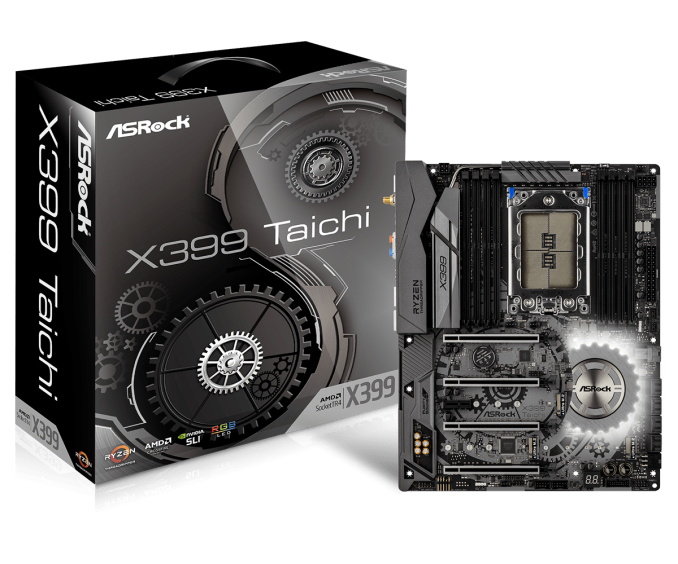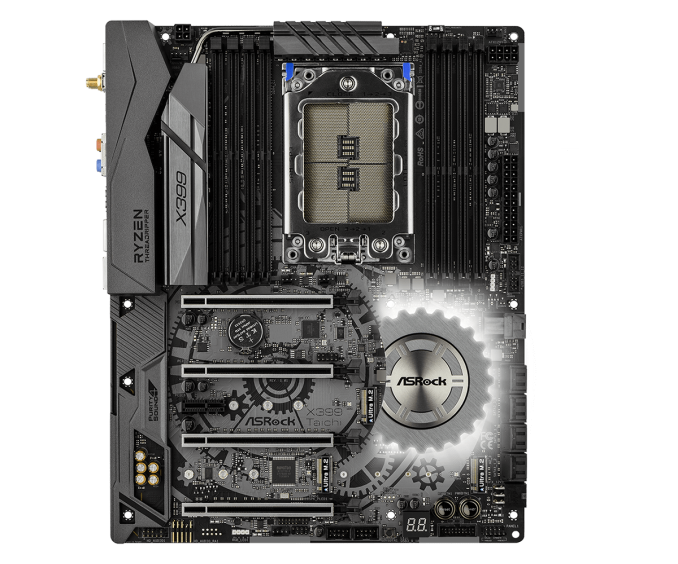An AMD Threadripper X399 Motherboard Overview: A Quick Look at Seven Products
by Ian Cutress & Joe Shields on September 15, 2017 9:00 AM ESTASRock X399 Taichi
The X399 Taichi is configured at a lower point down the ASRock product stack from the Professional Gaming. The Taichi forgoes 10 Gigabit Ethernet, and instead of the Creative Sound Blaster Cinema 3 suite for audio the Taichi uses Purity Sound 4 and a Realtek ALC1220 Codec.
Normally we associate ASRock’s Taichi models with black and white, but this time ASRock has made the board white and grey and drawing attention to the fact that the LEDs can be white if needed. So this means the X399 Taichi has a black PCB with gray accents in the shape of cogs on the PCB area between the PCIe slots and around the chipset heatsink. The DRAM slots are black, while the dual heatsinks for the VRM stretch around to the rear IO via a heatpipe are gray. Much like the Professional Gaming, the only integrated RGB LEDs are under the chipset heatsink, although there are two RGB LED headers for connecting additional RGB strips, all of which can all be controlled by the RGB LED application bundled with the board.
Just like the Professional Gaming, the Taichi supports up to 4-Way SLI and 4-Way Crossfire, with the PCIe slots reinforced using ASRock’s ‘Steel Slot’ protection. From top to bottom, the PCIe slots offer x16/x8/x16/x8 connectivity, taking 48 of the 60 PCIe lanes from the chipset. The final twelve are dedicated to storage with three onboard PCIe 3.0 x4 M.2 slots, one of which is switched with a U.2 connector. Other storage connectivity comes from eight SATA ports, supporting RAID 0/1/10.
The X399 Taichi uses two Intel I211AT gigabit Ethernet controllers, as well as an Intel 3168 1x1 802.11ac WiFi module.
In an almost copy-paste of the Pro Gaming, the Taichi uses the same digital 11 phase IR solution, along with the same EPS placement on the board. USB connectivity on the Taichi is the same as well, with three USB 3.1 (10 Gbps) Type-A ports on the rear panel, one USB 3.1 (5 Gbps) Type-C port on the rear panel, two onboard USB 3.1 (5 Gbps) headers for the front panel, and two USB 2.0 headers as well.
| ASRock X399 Taichi | |
| Warranty Period | 3 Years |
| Product Page | Link |
| Price | $339.99 |
| Size | ATX |
| CPU Interface | TR4 |
| Chipset | AMD X399 |
| Memory Slots (DDR4) | Eight DDR4 Slots, up to 3600 MT/s Supporting 128GB Quad Channel |
| Network Connectivity | 2 x Intel I211AT GbE |
| Wireless Network | 802.11 ab/g/n/ac Dual-Band (2.4/5 GHz) Bluetooth 4.2 |
| Onboard Audio | Realtek ALC1220 |
| PCIe Slots | 4 x PCIe 3.0 (x16/x8/x16/x8) from CPU 1 x PCIe 2.0 x1 from Chipset |
| Onboard SATA | 8x Supporting RAID 0/1/5/10 |
| Onboard SATA Express | None |
| Onboard M.2 | 3 x PCIe 3.0 x4 - NVMe or SATA |
| Onboard U.2 | 1 x PCIe 3.0 x4 (disables M2_1 when in use) |
| USB 3.1 | 1 x Type-A, 1 x Type-C (Rear Panel) |
| USB 3.0 | 8 x Rear Panel, 4x via internal headers |
| USB 2.0 | 4 x via internal headers |
| Power Connectors | 1 x 24-pin ATX 1 x 8-pin CPU |
| Fan Headers | 1 x CPU (4-pin) 1 x CPU Opt/Water Pump (4-pin) 2 x Chassis (4-pin) 1 x Chassis Opt/Water Pump (4-pin) |
| IO Panel | 2 x Antenna Ports 1 x PS/2 Mouse/Keyboard Port 1 x Optical SPDIF Out Port 1 x USB 3.1 Type-A Port 1 x USB 3.1 Type-C Port 8 x USB 3.0 Ports 4 x USB 3.0 Ports 2 x RJ-45 LAN Ports w/ LED 1 x BIOS Flashback Switch HD Audio Jacks |















99 Comments
View All Comments
HStewart - Friday, September 15, 2017 - link
You got to give some credit to AMD clever marketing teams by naming this x399 when Intel has x299 and then calling this the "The Most Advanced Desktop Motherboard in the World"But in reality there is no Thunderbolt 3.0 support and most likely be updated next year or later with PCIe 4.0 support.
Does it support DDR4-4600?
AMD sure likes to play numbers game and not just chipset name - but with number cores - just remember it mostly marketing - yes it still 16 cores - but 16 cores by one manufacturer does not mean 16 cores from completion.
sartwell - Friday, September 15, 2017 - link
Where is the high speed RAM? You cannot get it anywhere.HowardJones - Friday, September 15, 2017 - link
If you're considering the ROG Zenith be aware that it's having tons of problems overclocking CPU and memory. Theres a huge thread on overclock dot net that is filled with people having problems with the bios. There WAS an Asus rep who was trying to help, but he's pretty much disappeared in the last few weeks.tamalero - Sunday, September 17, 2017 - link
Seems like your average typical Asus mainboard.Asus has really huge troubles in their software segment. I still remember they needed like 50 patches to get their high end routers stable. And yet they couldnt get all what they promised in a working condition and even disabled some stuff in later firmwares.
Same with bioses.
I still remember a time where you had to enable the "floppy" connector in a motherboard (even if you had no drive) if you wanted the bios to actually apply the overclocking settings.
mapesdhs - Tuesday, September 19, 2017 - link
A note for those with older ASUS ROG and other ASUS X79 boards, etc.: there's a thread on the ASUS ROG forum site where a guy has provided modded BIOS files to support booting from NVMe devices, aswell as rolling in all the updates to the latest microcode, Intel RAID, etc. Very handy indeed, and he takes requests for other ASUS boards. SSDs like the 950 Pro have their own boot ROM, but a BIOS with boot support is perfect for the 960 EVO/Pro and other models which don't have their own boot ROM.I just bought two R4Es (one basically new), a 4930K, a 16GB/2400 DDR3 kit and a 120mm AIO for a total of 320 UKP. Who needs new stuff? :D My next new build will be TR or EPYC though I'm sure.
satai - Saturday, September 16, 2017 - link
Are any details on X399 AORUS Gaming 7 power delivery solution?The rumor was, that the used only 8 phase, but 8s this true for the final design?
danjw - Saturday, September 16, 2017 - link
The Asus Zenith Extreme claims to support 4-way SLI, but I thought Nvidia didn't support 4x slots for SLI? Am I wrong? Or is this a false claim?DanNeely - Saturday, September 16, 2017 - link
Cynically I'm going to guess that if you use several generation old cards that did support 4 way SLI you could combine all 4 together for an act of supreme WTFery.danjw - Saturday, September 16, 2017 - link
I looked at the manual for the Zenith Extreme. It claims the two that the block diagram of the board in this review indicates are 4x are 8x, with the lowest one on the board being 8x as long as you don't have a U.2 drive connected to the U.2 port. So, it is unclear which is correct the block diagram or the manual.danjw - Sunday, September 17, 2017 - link
Apparently, the block diagram wasn't clear. That last slot is 8x/4x depending on if you have a U.2 drive connected.